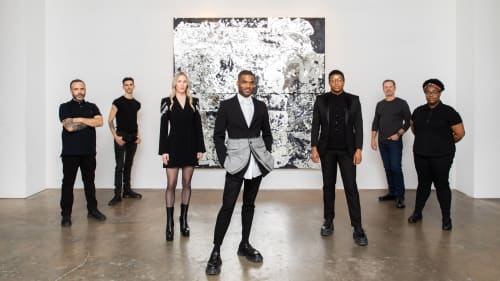Art equity has a long way to go for Black artists, but the Johnson Lowe Gallery is disrupting the statistics. The Atlanta-based, Black-owned gallery is presenting ‘The Alchemists’, an exhibition featuring works by 28 artists who are constructing new forms of expression rooted in the Black experience and ancestral legacies. Donovan Johnson, one of the youngest commercial gallery directors in the U.S. today, masterminded the project as part of the famed gallery's rebranding under his leadership. He has culled an extensive artistic roster, from the work of acclaimed late sculptor Thornton Dial to Shanequa Gay, an Atlanta-born mixed-medium artist whose arresting and empowering toile-pattened wall installations are also on display as part of New Worlds: Georgia Women to Watch at Atlanta Contemporary.
“We really wanted to have a collection of Black artists that are representative of this community,” exclaims Johnson, who hosted a dazzling opening night for exhibition with more than 200 guests. "The city is 48 percent Black, so it was a really important first thing to do," he adds.
“We wanted to show the conversations that are happening among contemporary artists that are surprising, challenging and risk-taking," shares Seph Rodney, who co-curated the exhibition. "I love that all of these pieces in some way are saying here's another way to think about Blackness."
Here, six artists featured in The Alchemists share their works, in their own words.
Shanequa Gay
“I'm an Atlanta native and my work is steeped in ritual and hybridity and southern mythology. I deal with that from a Black female perspective. This piece is my previous work from 2015 where I have hybrid figures running, leaping, jumping and escaping. For my piece featured at Atlanta Contemporary, Black women are very rarely the protagonists in fine art or literature and specifically southern Black women. So I created a landscape in which Black women with zebra attributes are part of the Southern-inspired mythologies in old paintings. Zebras will not fall asleep unless another is standing next to them. It’s a beautiful example of community.”
- Shanequa Gay
Ato Ribeiro
“This body of work is a series of kente cloths with repurposed wood that I find and piece together to express how people of African descent always used textiles to talk with each other and pass on information. There are Adinkra symbols and characteristics from West African strip weaving and African American quilting in the interwoven patterns and symbols. It's referencing a lot of Black and Brown bodies that were used to build this country, but are hidden behind the white wall. I grew up in Ghana, with tropical woods all over, so if you can slow down and appreciate it for that, maybe I can transfer those prejudices.”
- Ato Ribeiro
Ashante Kindle
“This piece embodies everything I feel about Blackness with the circle form calling to the Black body, head and crown. I'm thinking a lot about space and the act of rectifying the histories of my ancestors. It's not necessarily wanting to change history because, without it, I wouldn't be right here. But I do feel like it is important for me to come into these spaces where our bodies have historically been put on display in ways that we do not have control over and to be able to make work to begin to control the narrative. For me, this piece speaks a lot about joy, freedom and our refusal to give in.”
- Ashante Kindle
Yaw Owusu
“I've been exploring the ideas of Black contributions in the U.S., the global economy and the balance between reward and labor. I was going for earthly tones in terms of historical Black labor in the South, while gold is a symbol of wealth and greatness, all transformed through chemical, physical and mechanical activities which change the natural elements of metals in this work. It’s where the materials meet the complexity of society and the value of economics.”
- Yaw Owusu
Masela Nkolo
“I'm exploring things that happened in 2007 when I was 16 and dealing with internal conflicts in the Congo and the civil war that are still in my memories. In the country, in my school, we had many cultures and tribes. I worked with lanterns to represent each tribe and show that we can be different from different backgrounds, but when we have a problem we have to learn how to be together to be safe and how we can protect each other. Also, you see different materials in my work, like a closet shelf. Before I came to the United States my uncle told me, ‘I live in New York but I want to move in Atlanta. In New York City, people live in closets.’”
- Masela Nkolo
DARNstudio
“I’m Ron Norsworthy, one half of the art-life collaboration DARNstudio. This quilt-like sculpture is made out of matchbooks that represent the places where people of color have been killed by law enforcement. We like to refer to them as modern Underground Railroad quilts. Each one has a pattern that speaks to different forms of structural and institutional racism that contribute to the deaths of our brothers and sisters. And the work for us, as a mixed-race collaboration, was a way for us to resolve some of the intense conversations that we’ve had about why these killings occur and the circumstances that contributed to these unnecessary killings. So for us, we like to say that they are proof of the literal manifestation of our conversations and sometimes arguments.”
- DARNstudio
Check out ‘The Alchemists’ at the Johnson Lowe Gallery—through April 29—to view the works above as well as works by Sanford Biggers, Mark Bradford, Layo Bright, Danielle Deadwyler, Thornton Dial, William Downs, Leonardo Drew, Rico Gatson, Todd Gray, Trenton Doyle Hancock, Lyle Ashton Harris, Michi Meko, Shervone Neckles, Navin Norling, Masud Olufani, Yaw Owusu, Ebony G. Patterson, Devan Shimoyama, Renee Stout, Felandus Thames, Shoshanna Weinberger, Cosmo Whyte and Brenna Youngblood.


